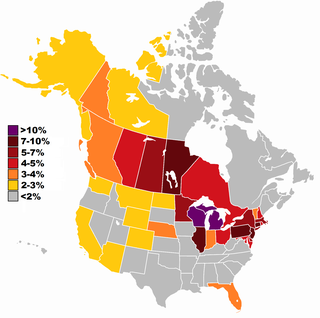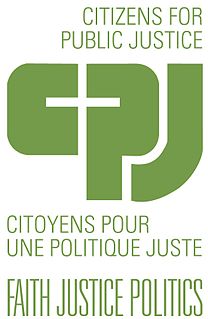
The legal system of Canada is pluralist: its foundations lie in the English common law system, the French civil law system
The Vietnam War had considerable effects on Canada, but Canada and Canadians also affected the war.
Immigration, Refugees and Citizenship Canada is the department of the Government of Canada with responsibility for matters dealing with immigration to Canada, refugees, and Canadian citizenship. The department was established in 1994 following a reorganization.
The Asiatic Exclusion League was an organization formed in the early 20th century in the United States and Canada that aimed to prevent immigration of people of Asian origin.

Polish Canadians are citizens of Canada with Polish ancestry, and Poles who immigrated to Canada from abroad. At the 2016 Census, there were 1,106,585 Canadians who claimed full or partial Polish heritage.

As of 2019, Canada has the eighth largest immigrant population in the world, while foreign-born people make up about one-fifth of Canada’s population—one of the highest ratios for industrialized Western countries.

Canadian immigration and refugee law concerns the area of law related to the admission of foreign nationals into Canada, their rights and responsibilities once admitted, and the conditions of their removal. The primary law on these matters is in the Immigration and Refugee Protection Act, whose goals include economic growth, family reunification, and compliance with humanitarian treaties.

Canada is a country in North America. Its ten provinces and three territories extend from the Atlantic Ocean to the Pacific Ocean and northward into the Arctic Ocean, covering 9.98 million square kilometres, making it the world's second-largest country by total area. Its southern and western border with the United States, stretching 8,891 kilometres (5,525 mi), is the world's longest bi-national land border. Canada's capital is Ottawa, and its three largest metropolitan areas are Toronto, Montreal, and Vancouver.
Opposition to immigration, also known as anti-immigration, has become a significant political ideology in many countries. In the modern sense, immigration refers to the entry of people from one state or territory into another state or territory in which they are not citizens. Illegal immigration occurs when people immigrate to a country without having official permission to do so. Opposition to immigration ranges from calls for various immigration reforms, to proposals to completely restrict immigration.

The economic impact of immigration is an important topic in Canada. Two conflicting narratives exist: 1) higher immigration levels helps to increase economy (GDP) and 2) higher immigration levels decreases GDP per capita or living standards for the resident population and leads to diseconomies of scale in terms of overcrowding of hospitals, schools and recreational facilities, deteriorating environment, increase in cost of services, increase in cost of housing, etc. A commonly supported argument is that impact on GDP is not an effective metric for immigration. Another narrative for immigration is replacement of the ageing workforce. However, economists note that increasing immigration rates is not an effective strategy to counter this entirely. Policy Options found that mass immigration has a null effect on GDP. Increased immigration numbers and the associated soaring housing prices has significantly contributed to the rise of inflation in 2021 to the highest in 18 years.

Illegal immigration is the migration of people into a country in violation of the immigration laws of that country or the continued residence without the legal right to live in that country... Illegal immigration tends to be financially upward, from poorer to richer countries. Illegal residence in another country creates the risk of detention, deportation, and/or other sanctions.
Slovak Americans are Americans of Slovak descent. In the 1990 Census, Slovak Americans made up the third-largest portion of Slavic ethnic groups. There are currently about 790,000 people of Slovak descent living in the United States.

The Canada–United States Safe Third Country Agreement (STCA) is a treaty, entered into force on 29 December 2004, between the governments of Canada and the United States to better manage the flow of refugee claimants at the shared land border.

Citizens for Public Justice (CPJ) is an ecumenical, non-profit organization that promotes justice in Canadian public policy through research and analysis focused on poverty reduction, ecological justice, and refugee rights.

Multiculturalism in Canada was officially adopted by the government during the 1970s and 1980s. The Canadian federal government has been described as the instigator of multiculturalism as an ideology because of its public emphasis on the social importance of immigration. The 1960s Royal Commission on Bilingualism and Biculturalism is often referred to as the origin of modern political awareness of multiculturalism.
Tibetan Canadians are Canadian citizens of Tibetan ancestry. Although Tibetan Canadians comprise a small portion of Asian Canadians, Canada holds one of the largest concentrations of Tibetans outside of Asia. Tibetans began immigrating to Canada as early as the early 1970s.

Racism in Canada traces both historical and contemporary racist community attitudes, as well as governmental negligence and political non-compliance with United Nations human rights standards and incidents in Canada. Contemporary Canada is the product of indigenous First Nations combined with multiple waves of immigration, predominantly from Asia and Europe.

Ahmed Hussen is a Canadian lawyer and politician who has been as the minister of housing and diversity and inclusion since October 26, 2021. A member of the Liberal Party, Hussen has also sat as the member of Parliament (MP) for the Toronto-area the riding of York South—Weston since the 2015 federal election. He previously served as the minister of families, children and social development from 2019 to 2021 and the minister of immigration, refugees and citizenship from 2017 to 2019. He is the first Somali-Canadian to be elected to the House of Commons and the first to hold a federal Cabinet position.
Zimbabwean Canadians are Canadian citizens of Zimbabwean descent or a Zimbabwe-born person who resides in Canada. According to the Canada 2016 Census there were 16,225 Canadian citizens who claimed Zimbabwean ancestry and 15,000 Zimbabwean citizens residing in the country at the moment of the census.

Roxham Road, known as Rang Roxham or Chemin Roxham for much of its length, is a 5-mile (8.0 km) rural road from the former hamlet of Perry Mills in the town of Champlain, New York, United States, generally north to the vicinity of the former hamlet of Bogton, in the municipality of Saint-Bernard-de-Lacolle, Quebec, Canada. It has existed since the early 19th century, before the Canada–United States border was formally established along the 45th parallel north between the St. Lawrence and Connecticut rivers. For most of its length it is a rural two-lane blacktop; north of Parc Safari, it is also part of Quebec Route 202.







